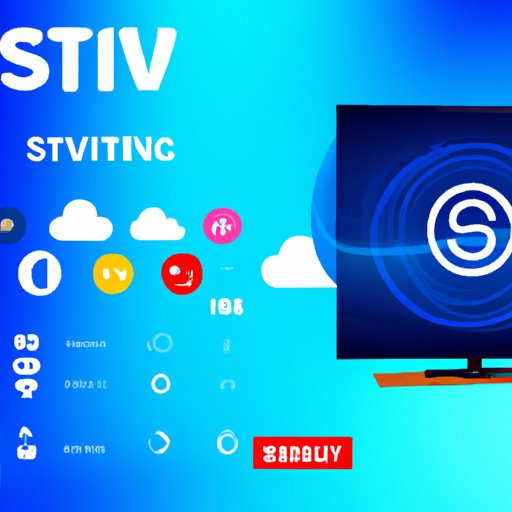Introduction
Streaming TV is revolutionizing the way people watch their favorite shows and movies. But what exactly is streaming TV and how does it work? This article will take an in-depth look at streaming TV technology and services to provide you with a better understanding of how streaming works.
Exploring the Basics of Streaming TV: How Does It Work?
Streaming TV can be defined as the method of delivering television content over the internet. Unlike traditional cable or satellite TV, streaming TV requires no hardware installation, and viewers can access programming from anywhere with an internet connection.
When it comes to streaming TV, there are two main types: live streaming and on-demand streaming. Live streaming involves watching programs as they are broadcast, while on-demand streaming allows viewers to watch pre-recorded content whenever they like. Both types of streaming require an internet connection, but live streaming often requires higher speeds for optimal performance.
The technology behind streaming TV is complex, but it basically involves three components: hardware, software, and infrastructure. The hardware includes the devices used to access streaming content, such as smart TVs, streaming boxes, and mobile devices. Software refers to the applications that enable streaming, such as streaming apps and web browsers. Finally, the infrastructure includes the networks that deliver content, such as the internet and cellular networks.

A Breakdown of Streaming TV Technology
In order for streaming TV to work, the correct hardware, software, and infrastructure must all be in place. Broadband speeds are also important for streaming, as higher speeds allow for smoother streaming and fewer issues with buffering. Audio and video codecs are also used to compress and decompress audio and video files, allowing them to be transmitted over the internet quickly and efficiently.
The type of device being used to stream content can also affect the quality of the stream. Smart TVs, streaming boxes, and gaming consoles are typically the best devices for streaming, as they are designed specifically for streaming content. Mobile devices, on the other hand, may not be able to handle high-definition streaming due to limited processing power.
What You Need to Know About Streaming TV
To get started with streaming TV, you’ll need to make sure you have a compatible device. Most streaming services are available on a variety of devices, including smart TVs, streaming boxes, gaming consoles, and mobile devices. Once you have a compatible device, you’ll need to choose a streaming service package. Different streaming services offer different packages, so it’s important to do your research and find one that fits your needs.
Depending on the type of device you’re using, you may also need additional equipment. For example, if you’re streaming on a smart TV, you may need an HDMI cable to connect your TV to the internet. If you’re streaming on a mobile device, you may need a Wi-Fi hotspot or a data plan. It’s important to check the requirements of your device before streaming.

The Pros and Cons of Streaming TV
Streaming TV has a number of advantages. For starters, it’s much more affordable than traditional cable or satellite TV. Streaming services also offer a wide variety of content, from live sports to classic movies. And because streaming is internet-based, it can be accessed from anywhere with an internet connection.
However, streaming TV also has some drawbacks. One of the biggest drawbacks is that streaming can be unreliable due to internet outages or slow speeds. Additionally, streaming services often require users to sign up for multiple services in order to access all of their desired content, which can become expensive. Finally, streaming services may not be available in certain areas due to licensing restrictions.

Understanding the Different Types of Streaming Services
When it comes to streaming services, there are three main types: subscription services, pay-per-view services, and free streaming services. Subscription services, such as Netflix and Hulu, require users to pay a monthly fee in exchange for access to their library of content. Pay-per-view services, such as Amazon Prime Video, allow users to pay for individual episodes or movies. Finally, free streaming services, such as YouTube and Pluto TV, offer users access to a selection of free content.
Conclusion
Streaming TV is quickly becoming the preferred method of watching television, and for good reason. With its affordability, convenience, and wide selection of content, streaming TV is the perfect alternative to traditional cable or satellite TV. This article has provided an in-depth exploration of streaming TV technology and services, as well as the pros and cons of streaming TV and the different types of streaming services.
Whether you’re looking to cut the cord or just want to explore the world of streaming TV, this article has given you the information you need to make an informed decision. Remember to do your research and find the streaming service that best suits your needs.


